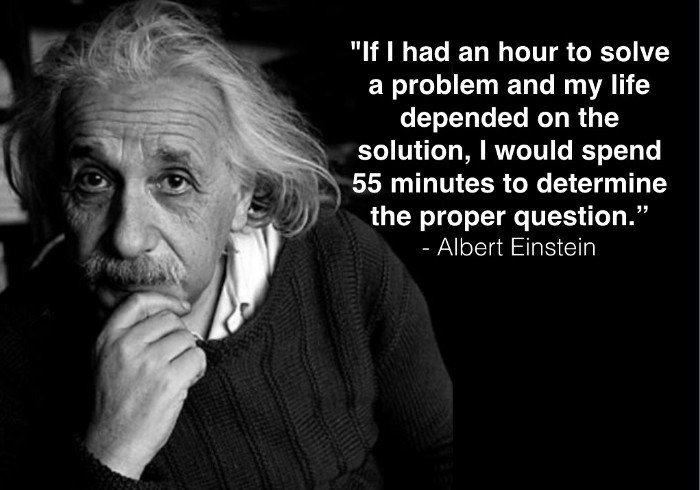Why did Einstein say framing the right question is important?

Consider, for example, ceiling fans — most often, surface level or incorrect questions will lead to an object-oriented design of it and will end up in aesthetic modification or some bit of functional correction. One would never work upon its subject — to reduce the body core temperature (and not to reduce the temperature of the room or to throw air around). Some AC manufacturers are working on improving buildings rather than improving their AC’s, Chinese Taipei Government and Indore Municipal Corporation dramatically reduced their waste and waste management problem, Dyson changed the way fans and vacuum cleaners could be, reverse time counters on traffic signals reduced our anxiety and many accidents. These are a few examples of how the right questions could lead to simple and effective innovations.
In a rapidly changing world, with dynamic requirements, assumptions will change, including potentially the assumptions that made a particular approach the best one, or made a performance objective the most relevant. Asking the right question is a uniquely powerful tool for unlocking value in an organisation or an individual: It spurs learning and the exchange of ideas, it fuels innovation and performance improvement, and it can mitigate business risk by uncovering unforeseen pitfalls and hazards. The right question takes you close to the root or the core or the subject of the challenge or problem. If you ask fundamental subject-oriented questions numerous possibilities and opportunities will open up for breakthrough innovation.
The right question helps you break out of incremental tendencies. Incrementalism makes us believe we are doing OK, but it can obscure the real danger of falling ever further behind more rapidly advancing alternatives and expectations. But it’s one thing to understand that incremental efforts are not enough and another to let go of running a little harder on the business-as-usual treadmill and to really look for what might make the treadmill obsolete. Framing the right question can break the barrier, pop the bubble of complacency, push you to reconsider the rules of the game. A right question has the power to make you step back and ask: Why is this product or service needed? Why does our organisation exist? Is this what we should be doing? What else is possible? Are the organisations shared outcomes still the most relevant and important thing you should be focused on?
The right question is:
- Deep and authentic: Powerful questions should expose what you don’t yet know
- Compelling: A powerful question should pull people out of an incremental mindset, refocusing how to achieve an entirely new level of impact
- Wide and open-ended: Instead of inspiring a single, definitive answer, the right question should open things up
- Purposeful and focused: A right question should start with a WHY and then lead to What and How question/s
- Verb-based and actionable. The right question should be based on deep insight and should push you to take action
Examples of right questions:
- Why do we need a particular appliance or what purpose does it really serve? (see the ceiling fan example above)
- Why do we want to make our trains even faster? (is reaching early psychological or notional. Can we deal with this question differently)
- How do we grow higher-quality food in a future with half the water supply?
- Why do people jump traffic signals which lead to chaos and accidents?
- Why do people waste and litter and how do solve waste management problems?
- How can we use technology to see the impact of our decisions and make better ones?
The right question would get you closer to the root of the problem, reduce entropy, and shed light on new approaches to consider that weren’t necessarily the original, “assumed” problem. Right questions have the power to transport us to unimagined scenarios and transform the way we see reality. When people see things from a new perspective, innovation happens.
So the next time you are designing a pen, ask yourself the right question, if you are designing merely an object (pen), or you’re designing for its subject (communication). What sort of a pen would make you more romantic or what sort of pen makes you write more or communicate better.
(This Perspective was originally published on July 17, 2021 by Shekhar Badve on LinkedIn)
